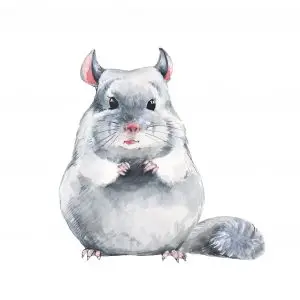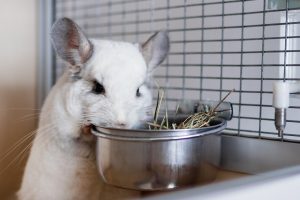- The average pet chinchilla lifespan is 15-20 years
- The average wild chinchilla lifespan is ~8 years (Source)
Chinchillas are a mammal that is found in the Andreas mountain in South America. The wild chinchillas that were found are much different compared to the pet chinchillas nowadays. One huge difference is in lifespan. So let’s look at everything that is to know about chinchilla life span.
Chinchilla life expectancy on average

Of course, the life expectancy of your chinchilla depends on the quality of life, like living a healthy life and proper care. However, knowing the life expectancy of chinchilla before becoming their pet owner is essential as well.
There are many species of chinchillas, but on average, they have an average lifespan of 15 to 20 years. Yes, the lifespan varies on whether they grew up in the wild or in captivity. Domestic chinchillas usually live longer than wild ones. These animals with docile nature can live for a long time, compared to other pet animals.
The best way to make chinchillas live as long as possible is by controlling their ambient temperature. Ensure to take care of chinchilla health and have a pet for a long time!
Wild chinchilla life expectancy
As mentioned above, domesticated chinchilla and wild chinchilla have different life expectancies. This is again due to many factors, as chinchillas in the wild get predated upon by animals and hunters, fall sick, and don’t have enough food. These hungry and sick chinchillas don’t even get the care that they require.
All these factors contribute to these animals with docile nature dying early. The average life expectancy of a chinchilla in the wild is less than 10 years, generally about 8 years. This would be higher if these animals with docile nature didn’t get hunted by people. The reason these hunters target wild chinchillas is for chinchilla fur, which is extremely soft and luxurious.
Moreover, chinchilla skin was exported a lot during 1900 and 1909, which also led to their almost extinction. This has lead to hunting for chinchillas, a banned sport, but sadly it doesn’t stop everyone.
Domestic chinchilla life expectancy
The chinchillas in captivity are given proper medical care and nutritious food, leading them to have a better quality of life. This also means that they live for longer than the wild ones.
The domesticated chinchillas can live for two decades or for 15 to 20 years with proper care, diet, and a companion. This is why, if you want to be a chinchilla owner, you need to put enough time and effort into taking care of them, so they can have a long and healthy life. Chinchillas love affection and get attached to their owners easily, which is why you need to hold and pet your chinchilla regularly.
Before buying a pet chinchilla, make sure to do your research and ask people who have this pet to take care of them and expect when buying one properly.
Why do chinchillas live so long?
After reading about how long a chinchilla lifespan can be, you must have wondered why. You can keep many animals as pets, but very few of them have a long lifespan.
The thing is, chinchillas are actually very strong animals, even if they seem docile and weak. The chinchilla in captivity will not need to hunt for food and starve if there isn’t appropriate food for it.
Another reason that chinchillas live long in captivity is that in captivity, the pet owner takes care of the body temperature of this animal. Chinchillas are very sensitive when it comes to their body temperature and require a cool temperature to survive.
This is impossible to control in the wild, but this can be controlled using an air conditioner and whatnot when in captivity. These animals also get dehydrated very easily, so if they don’t get the water, they can suffer from a variety of medical problems.
Long-Tailed Chinchilla Lifespan vs. Short-Tailed Chinchilla Lifespan
There are two species of chinchillas, the short-tailed chinchilla, and the long-tailed chinchilla. The short-tailed chinchilla is also known as Bolivian chinchilla, and long-tailed chinchillas are mostly the ones we have as pets.
Although these shy creatures have a long lifespan, only a few of the chinchillas reach their theoretical maximum lifespan. The long-tailed chinchilla has a life span that is lover than that of short-tailed chinchillas. The long-tailed chinchilla lives for around 18 years, but if they reach the age of 15 years, one should assume that they have lived for a very long time and were given optimal living conditions.
The short-tailed chinchillas, which are not our pets, are said to have a longer life span. These furry creatures can live for more than 20 years. This, however, again is a theoretical age that is mostly not reached. Chinchilla vets can sometimes help extend their lives, but they can’t be more than 26 years of age.
Tips to maximize your pet’s lifespan

If you decide to have a pet chinchilla, you want the pet to live for as long as possible. To extend a chinchilla’s life, you need to take care of some things like their body temperatures, and you also need to have some tips about chinchilla care that you need to know before you decide to buy this docile animal.
- Be prepared for medical emergencies: This means knowing a good chinchilla vet and knowing beforehand about the type of infectious diseases that these animals are prone to. Even small symptoms like your pet having difficulty chewing food can be due to a much bigger problem. The most important thing is to keep an eye on your pet and learn their behavior so that any deviation from their normal behavior is immediately noticeable.
- Control humidity: If you decide to own a pet chinchilla, know that they are very sensitive, especially about humidity. Chinchillas actually originated from a desert place, so they are used to living in dry conditions; therefore, you have to take extra care if you live in a humid place. You can control the humidity through the dehumidifier and make sure that the humidity is below 50%, as high humidity can cause bacteria and fungus to grow on their furs.
- Dust baths: A chinchilla needs its dust bath to survive. This is how they clean themselves instead of cleaning with water. Chinchillas need to have a dust bath shower every two days. They use this to lower their body temperature and improve coat health. The dust bath container should be big enough for them to roll around in and, in summer, should be cooled in the refrigerator beforehand.
- Use chemical-free cleaners: As chinchillas are very sensitive animals, they require sensitive care as well. When cleaning their cage as well as their toys, you should always use cleaners that are plant-based. If not, then the cleaners can enter your pet’s stomach and cause a variety of diseases. The best type is the natural enzyme cleaners, which work just as well as other cleaners and also are very budged friendly.
- Encourage water drinking: Chinchillas get a high body temperature very easily, so they need to drink plenty of water to remain safe and healthy. For this, you need to provide the chinchillas with a constant supply of clean water. This is especially true in the summer; make sure they have excess water, so they never run out of it. Of course, water helps them cool down, but it also helps them flush any toxins; just make sure to use glass water bottles.
- Appropriate cage size: A chinchilla cage are where the chinchillas spend all of their lives in, so it needs to be big enough. The cage should be tall enough and big enough that the chinchillas can run around and have ramps as chinchillas are very active. A small cage can give them a lot of diseases like diabetes and depression as they are lively animals that should be able to run around.
- Add a shaded area in the cage: Like humans, chinchillas also need a private area where they can relax like a shaded area. Moreover, this can be used by them when there is excess sunlight entering their cages. In the wild, the chinchillas used to live in burrows and tunnels, so they need a hidden and shaded place to feel comfortable and safe. They don’t need to be hidden from predators, but they still need a place to rest.
- Handle your chinchilla with care when picking them up: After playtime is over, your pet chinchilla might try to run much faster to avoid going back to their cages. However, you should still try to pick them with care instead of catching them since these animals have a defense mechanism known as fur slip, where their hair falls when they are stressed. The best course of action is to lure them with food inside the cage.
- Control air conditioning and temperature: This is one of the most important parts of caring for a chinchilla. Make sure to keep your pet in a room with AC so that the temperature of the room stays between 60 to 70 degrees Fahrenheit at all times. Chinchillas don’t have the ability to sweat, so they don’t know how to cool down. Moreover, they have 60 to 70 hair per hair follicle, whereas a human has 1 hair per hair follicle. This means that they are very prone to overheating.
In conclusion, taking care of a pet chinchilla is easy if you know the signs and can take care of it love. Once they trust you, you will have a loyal pet with a long lifespan with proper care. Just make sure to be totally sure of what you want before you decide to adopt a chinchilla.
Hi, my name’s Elena Coolidge, and this is my site. Chinchillas are so cute and such intelligent animals that make great pets. They’ve become the subject of fascination for many animal lovers who enjoy their antics. I blog about their care, where to buy them, breeders, and more. Shoot me an email if you have a question!

